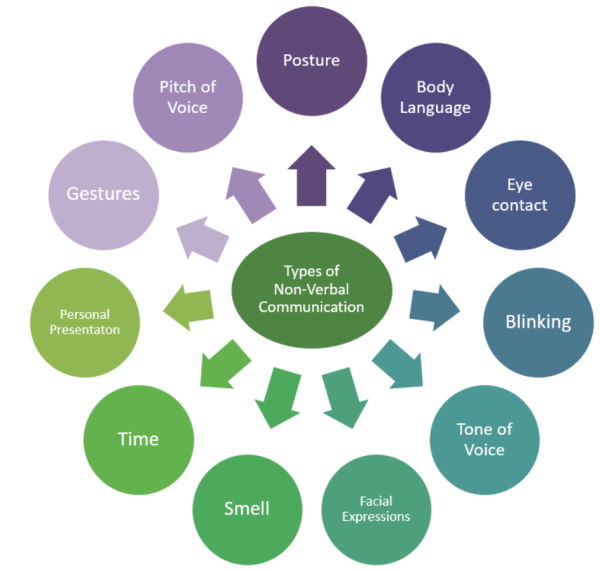Statistics on Communication – 93% of all daily Communication is Nonverbal
We all experience it on a daily basis. Communication for which no words are needed. Nonverbal communication, as it is called.
One often quoted statistic on communication is that 93% of all daily communication is actually nonverbal.
Specifically, Albert Mehrabian, a pioneer researcher of body language in the 1950’s, found that only 7% of any message is conveyed through words, 38% through certain vocal elements, and 55% through nonverbal elements like facial expressions, gestures, posture, etc.
With the overall percentage of actual verbal content amounting to only 7%, our daily communication is therefore to 93% nonverbal.
All various forms of it combined make a big percentage of what our daily communication with others looks like, without having to use proper words.
And while the key to success in both personal and professional relationships lies in your ability to communicate effectively, it’s not the words that you use but your nonverbal cues or “body language” that speak the loudest.
Non-verbal communication is hereby vastly underrated.
Not only do most of us not realize how much we really communicate every day without actually using words, we also tend to underestimate the impact our non-vocal expressions can have with the recipient.
The following chart by Bridget Higton provides a good example of various types of non-verbal communication, we may not even think of.
Let’s look at some of the questions related to non-verbal communication:
-
What is “nonverbal” Communication?
-
How often is our Communication nonverbal?
-
What Forms of nonverbal Communication we practice – intentionally or not?
-
Finding the Balance between nonverbal and verbal Communication
1. What is “nonverbal” Communication?
“Nonverbal” communication can be expressed in many different ways. It can be expressed through hand gestures, nods, using your body in various other ways, making eye contact with someone, or through the sound of your voice.

2. How often is our Communication nonverbal?
The question is: How often do we actually use non-verbal communication? And why? What are major reasons behind it?
Anthropologist Ray Birdwhistell, like Mehrabian, found that the verbal component of a face-to-face conversation is less than 35 percent and that over 65 percent of communication is done nonverbally.
3. What Forms of nonverbal Communication we practice – intentionally or not
A good example of the use of non-verbal communication can be found not only in romantic relationships between e.g. women and men, but also in children.
The earliest form of communication they use with their caretakers is indeed non-verbal.
[ctt template=”5″ link=”50Dl7″ via=”yes” ]Care about the way you communicate non-verbally! Nonverbal communication can say more than words and it can also be as hurtful![/ctt]
Babies are making sounds, of course, but they can be categorized as non-verbal in many cases.
Coo-cooing sounds, grasping one’s finger as a sign of comfort, or even undistinguished crying are all ways of communicating before they acquire the skills of speaking.
It’s fascinating to see how much we can understand from these given clues, and how we continue throughout adolescence and adulthood to rely on non-verbal communication in situations where words fail us, or simply seem superfluous.
We should pay closer attention to some of those non-verbal cues, in particular in relationships where we constantly wonder and ask ourselves about our partner’s level of affection or love towards us.
Paying close attention to non-verbal communication could help answering questions as to whether e.g. your “ex” wants you back or in general could it help understanding your partner better.
Once we are used to a routine, whether it be with our children or spouse, we learn how to make tasks simpler for each other.
It could be a swift move of the hand to indicate you’d like your child to move along a bit quicker, or a subtle gesture towards an item you’d like to be given (like a salt shaker or napkin).
Often, these are precious little moments; easily understood and time-saving for everyone involved.
From my own experience, I would go as far and say that way over 50% of communication in a regular day is non-verbal.
I live in a household where daily conversations are a given and talking is an essential component of having meals together, but I also understand that not every family emphasizes or is interested in as much verbal communication as we are. So it really depends on the situation at home, and who is around.
However, the reality is that the exact number, the exact split between verbal- and non-verbal communication is not the most crucial aspect.
Or, as Blake from the “Nonverbal Group” notices in “How much of communication is really nonverbal?”, it does not matter so much whether exactly 75%, 80% or even 90% of communication is non-verbal.
What matters is to understand that most communication is in fact nonverbal. Hence, nonverbal behavior is the most crucial aspect of communication.
Then, secondary, we have to think of the non-verbal communication we partake in outside of our home.
You might be in a car and are signaled to go ahead of the other driver. Then a wave or nod would be appropriate to acknowledge it, wouldn’t it be?
How often have you found yourself in such a situation? It might easily be a daily occurrence on your way to work.
Or maybe you like to give out a smile to the barista who just handed you your drink order.
There are so many situations in which we decide to remain quiet, but still like to express our gratitude, anger, or love for another person in a non-verbal way.
We do it all the time, every day! Often times we do these things without being aware of it.
The interesting aspect of it all is that there’s no loss of significance by communicating in such a manner.
Sometimes the effect and impact is actually greater through non-verbal communication than if we used our words.
Looking into someone’s eyes, for example, can be profound and deeply moving.
Holding a hand can be the most meaningful thing in the world, especially during sickness of a loved one.
Communication in general plays a vital role in creating a healthy relationship. This holds true for both verbal as well as non-verbal communication.
When you combine it all, there’s a tremendous amount of non-verbal communication going on, and it’s beautiful.
However, in any type of relationship this can only be a supplement to an already existing, verbal communication.
You can’t replace one with the other, for obvious reasons. A romantic relationship, for instance, needs constant verbal communication in order to survive.
There’s hugging, kissing, cuddling and smiling at each other – but when it comes to serious topics, you also need to have those verbal conversations that you otherwise would like to try to avoid.
[Also read: How can you tell if a Guy likes You]
This is one of the most important points:
4. Finding the Balance between nonverbal and verbal Communication
Finding a healthy balance is key. Make sure to tell people “thank you” and “you’re welcome”, but sometimes a smile is all that is needed, and can contribute to making someone’s day a little brighter.
To summarize on non-verbal communication: It’s a big portion of any communication we partake in, and we can’t avoid it being that way.
[Further Reading: Relationship Advice for Women]
It’s a simple, human, instinctive, and, might I even say, fun way to interact with others.
I know that I love kissing my daughter on her cheek, without uttering a single word, and by me doing that, she knows that I care for her and love her.
That’s what nonverbal communication can do and it’s a good reason to keep doing it.
